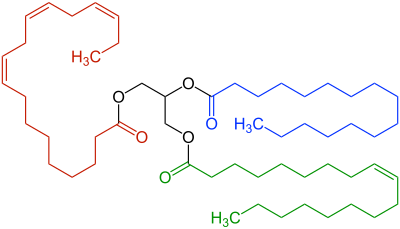

Lipolysis /lɪˈpɒlɪsɪs/ is the metabolic pathway through which lipid triglycerides are hydrolyzed into a glycerol and free fatty acids. It is used to mobilize stored energy during fasting or exercise, and usually occurs in fat adipocytes. The most important regulatory hormone in lipolysis is insulin; lipolysis can only occur when insulin action falls to low levels, as occurs during fasting. Other hormones that affect lipolysis include leptin,[1] glucagon,[2] epinephrine, norepinephrine, growth hormone, atrial natriuretic peptide, brain natriuretic peptide, and cortisol.[3]
- ^ Wang, May-Yun; Lee, Young; Unger, Roger H. (June 1999). "Novel Form of Lipolysis Induced by Leptin". Journal of Biological Chemistry. 274 (25): 17541–17544. doi:10.1074/jbc.274.25.17541. PMID 10364187.
- ^ Duncan, Robin E.; Ahmadian, Maryam; Jaworski, Kathy; Sarkadi-Nagy, Eszter; Sul, Hei Sook (August 2007). "Regulation of Lipolysis in Adipocytes". Annual Review of Nutrition. 27 (1): 79–101. doi:10.1146/annurev.nutr.27.061406.093734. PMC 2885771. PMID 17313320.
- ^ Nielsen, TS; Jessen, N; Jørgensen, JO; Møller, N; Lund, S (June 2014). "Dissecting adipose tissue lipolysis: molecular regulation and implications for metabolic disease". Journal of Molecular Endocrinology. 52 (3): R199–222. doi:10.1530/JME-13-0277. PMID 24577718.